
Caterpillars are the larval stage of members of the order Lepidoptera.

Tsuga heterophylla, the western hemlock or western hemlock-spruce, is a species of hemlock native to the west coast of North America, with its northwestern limit on the Kenai Peninsula, Alaska, and its southeastern limit in northern Sonoma County, California. The Latin species name means 'variable leaves'.
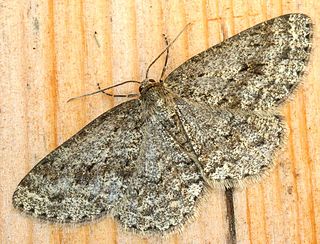
The engrailed and small engrailed are moths of the family Geometridae found from the British Isles through central and eastern Europe to the Russian Far East and Kazakhstan. The western Mediterranean and Asia Minor and the Caucasus represent the southern limit of the distribution. In the north, the distribution area ends at the Arctic Circle. It also occurs in North America. Debate exists as to whether they make up one species, or whether E. crepuscularia actually refers only to the small engrailed, with the engrailed proper being separable as E. bistortata.
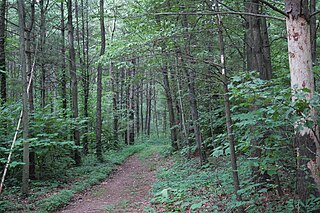
Joseph E. Ibberson Conservation Area is a 783-acre (317 ha) Pennsylvania state park in Middle Paxton and Wayne Townships, Dauphin County, Pennsylvania in the United States.
The inland rainforest, also known as the inland temperate rainforest in the classification system of the WWF, is a temperate rainforest in the Central Interior of British Columbia. It is part of the Interior Cedar Hemlock (ICH) zone of the biogeoclimatic zones system developed by the BC Ministry of Forests, in the Rocky Mountain Trench. One of the richest parts of this wet belt lies 110 kilometres (68 mi) east of the city of Prince George and nearly a thousand kilometres east of the coastal rainforests. The oldest and most diverse parts of the forest are typically found on northeasterly aspect wet toe slopes, with Western Red Cedar trees over 1,000 years old and undisturbed forest stands much older than that. Some of these toe-slope benches were cleared in the 1960s to develop the Yellowhead Highway, with the added result that most of the remainder became easily accessible to industrial logging and recreation, and more recently to research and interpretation. As a consequence there are only a handful of the best sites left undisturbed in 2008.

Macaria brunneata, the Rannoch looper, is a moth of the family Geometridae. The species was first described by Carl Peter Thunberg in 1784. It is found in Siberia, Japan, and northern and mountainous parts of North America, and throughout Europe, though in Britain it is largely or entirely restricted to mature forests in central Scotland.

The hemlock moth, also known as the defoliating hemlock moth or poison hemlock moth, is a nocturnal moth species of the family Depressariidae. Of Palaearctic origin, it was first found in North America in 1973 when it was accidentally introduced. The moth is now widespread throughout the northern half of the United States, southern Canada, northern Europe, and, more recently, New Zealand and Australia. The larval form grows to around 10 mm, while the adults wingspan is between 17 mm and 19 mm.
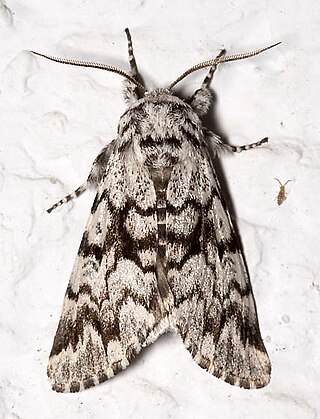
Panthea acronyctoides, the black zigzag or tufted spruce caterpillar, is a moth of the family Noctuidae. The species was first described by Francis Walker in 1861. It is found in North America from Newfoundland to British Columbia and adjacent northern states, south in the west to Colorado, south in the east to New England and Kentucky.

Lambdina fervidaria, the curve-lined looper or spring hemlock looper, is a moth of the family Geometridae. It is found in Canada and the eastern parts of the United States, south to Georgia.

Nepytia canosaria, the false hemlock looper, is a moth of the family Geometridae. The species was first described by Francis Walker in 1863. It is found from southwest British Columbia east to Nova Scotia and Newfoundland, south through New England.
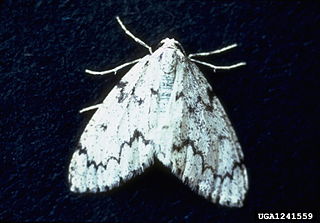
Nepytia freemani, the western false hemlock looper, is a moth of the family Geometridae. The species was first described by Eugene G. Munroe in 1963. It is found in North America from southern British Columbia and extreme southwestern Alberta south to Washington, Idaho, Montana and Utah.
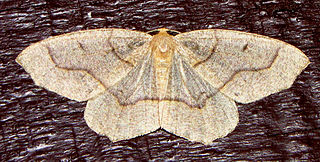
Lambdina is a genus of moths in the family Geometridae first described by Hahn William Capps in 1943.

Abagrotis alternata, the greater red dart or mottled gray cutworm, is a moth of the family Noctuidae. The species was first described by Augustus Radcliffe Grote in 1865. It is found in eastern North America, from New Brunswick west across southern Canada to western Alberta, south to Arizona, New Mexico and the Gulf of Mexico.
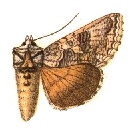
Syngrapha selecta, the chosen looper moth, is a moth of the family Noctuidae. The species was first described by Francis Walker in 1858. It is found in North America from the Northwest Territories to Newfoundland south to northern Michigan.

Syngrapha epigaea, the pirate looper moth or narrow silver Y, is a moth of the family Noctuidae. The species was first described by Augustus Radcliffe Grote in 1874. It is found from coast to coast in Canada south in the east to Pennsylvania, Ohio, and the northern Great Lakes states.

Protoboarmia porcelaria, the porcelain gray or dash-lined looper, is a Geometrid species of moth found throughout North America, except in the far north. The species was first described by Achille Guenée in 1857.
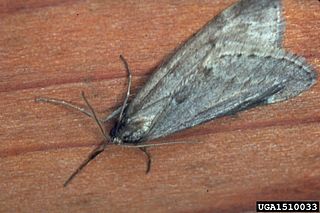
Alsophila pometaria, the fall cankerworm, is a moth of the family Geometridae. It is found in North America from Nova Scotia west to Alberta, south to Colorado and California and zones of Spain
Lambdina pultaria, the southern oak looper, is a species of geometrid moth in the family Geometridae. It is found in North America.
The Nabisipi River Old Forest is a protected area of old-growth forest in the Côte-Nord region of Quebec, Canada. It is classified as an exceptional forest ecosystem.
The Chécatica River is a salmon river in the Côte-Nord region of Quebec, Canada. It empties into the Gulf of Saint Lawrence.




















